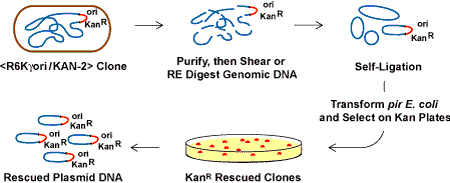Among the advantages of transposon mutagenesis is that the transposon serves as a marker that can be used to clone and sequence the region of genomic DNA that has been disrupted. Nothing makes this cloning process easier than creating mutations in vivo with the EZ-Tn5™ <R6Kγori /KAN-2>Tnp Transposome. In addition to encoding a kanamycin-resistance gene, the transposon contains an E. coli conditional origin of replication (R6Kγ ori). The presence of this origin of replication enables you to propagate or 'rescue' the region of genomic DNA into which the transposon has been inserted.
First, electroporate the Transposome into electrocompetent cells of the highest possible transformation efficiency. Activation of the Transposome by Mg2 in the cell results in the random insertion of the EZ-Tn5™5 <R6Kγori /KAN-2> Transposon into the host's genomic DNA. Select transposition clones on kanamycin plates or by screening for the loss of gene function.
The presence of one or more type I restriction and modification systems may lower transposition efficiencies. Epicentre® scientists have shown that these systems can be blocked in vivo with the TypeOne™ Restriction Inhibitor.
Rescue clone the transposon insertion site by a three step process: (Figure 1)
- Purify genomic DNA from a single kanamycin resistant insertion clone or a pool of clones, and then fragment the DNA by digestion with restriction endonuclease(s) or by random shearing.
- Self-ligate the genomic DNA fragments using Fast-Link™ DNA Ligase or another suitable ligase. For efficient ligation of randomly sheared DNA, the ends of the DNA can be repaired using the End-It™ DNA End-Repair Kit prior to ligation.
- Transform an E. coli host expressing the p protein (pir-gene product), such as TransforMax™ EC100D™ pir or TransforMax™ EC100D™ pir-116 Electrocompetent E. coli and select on kanamycin plates. Only those clones containing the EZ-Tn5™ <R6Kγori /KAN-2> Transposon will grow.
Rescue clones can be sequenced bidirectionally using the provided primers that are homologous to the ends of the transposon.
 |
| Figure 1. The process for rescue cloning of transposon insertion sites in genomic DNA using the EZ-Tn5™ <R6Kγori/KAN-2>Tnp Transposome™ and TransforMax™ EC100D™ pir or TransforMax™ EC100D™ pir-116 Electrocompetent E. coli. |
If you cannot find the answer to your problem then please contact us or telephone +44 (0)1954 210 200